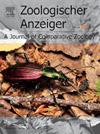利用几何形态计量学揭示J/K过渡时期的形态差异和区系变化:以智利中部菊石为例
IF 1.5
3区 生物学
Q2 ZOOLOGY
引用次数: 0
摘要
在不同的时空尺度上,物种多样性的变化可能伴随着形态空间的变化。有证据表明,在整个地质尺度上,海洋无脊椎动物物种多样性和形态差异(morphodisparity)的变化是普遍存在的。本研究通过对智利中部4个地区的158个标本(33种21属)进行研究,估计了侏罗纪-白垩纪(J/K)过渡时期(从梯东纪到瓦兰吉尼纪)菊石的多样性和形态差异。对菊石进行侧面和正面拍摄,根据地标和半地标进行几何形态计量学分析。利用不同地质阶段的多元统计方法对所得形状进行了评估。结果表明,J/K转换期间的区系多样性变化与菊石形态空间的显著变化有关。值得注意的是,在泰东晚期和早期贝里亚时期之间,以及在早期和晚期贝里亚时期之间,观察到明显的形态差异变化。这项研究不仅记录了智利中部的动物更替,而且有助于我们理解灭绝脉冲如何在关键的进化转变中驱动形态创新或限制。本文章由计算机程序翻译,如有差异,请以英文原文为准。
Unravelling morphological disparity and faunal change across the J/K transition using geometric morphometrics: A case study of ammonites from central Chile
Changes in species diversity may be accompanied by morphospace variation at different spatial and temporal scales. Evidence indicates that shifts in species diversity and morphological disparity (morphodisparity) are prevalent among marine invertebrates across the geological scale. This study estimates the diversity and morphodisparity of ammonites across the Jurassic–Cretaceous (J/K) transition—from the Tithonian to the Valanginian stages—by examining 158 specimens representing 33 species and 21 genera from four localities in central Chile. Ammonites were photographed in lateral and frontal views to perform geometric morphometrics analyses based on landmarks and semilandmarks. The resulting shapes were evaluated using multivariate statistical approaches across geological stages. Results suggest that faunal changes in diversity during the J/K transition are associated with significant variations in ammonite morphospace. Notably, significant changes in morphodisparity were observed between the late Tithonian and early Berriasian, and again between the early and late Berriasian. This study not only documents faunal turnover in central Chile but also contributes to our understanding of how extinction pulses can drive morphological innovation or constraint during key evolutionary transitions.
求助全文
通过发布文献求助,成功后即可免费获取论文全文。
去求助
来源期刊

Zoologischer Anzeiger
生物-动物学
CiteScore
2.80
自引率
7.10%
发文量
75
审稿时长
>12 weeks
期刊介绍:
Zoologischer Anzeiger - A Journal of Comparative Zoology is devoted to comparative zoology with a special emphasis on morphology, systematics, biogeography, and evolutionary biology targeting all metazoans, both modern and extinct. We also consider taxonomic submissions addressing a broader systematic and/or evolutionary context. The overall aim of the journal is to contribute to our understanding of the organismic world from an evolutionary perspective.
The journal Zoologischer Anzeiger invites suggestions for special issues. Interested parties may contact one of the editors.
 求助内容:
求助内容: 应助结果提醒方式:
应助结果提醒方式:


